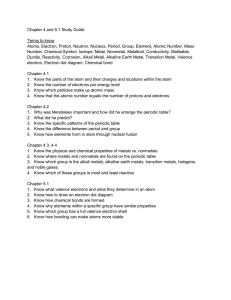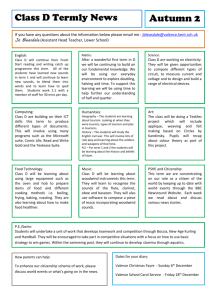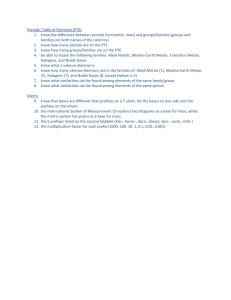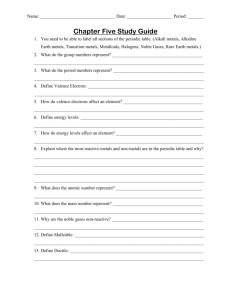The Power of the Periodic Table!
advertisement
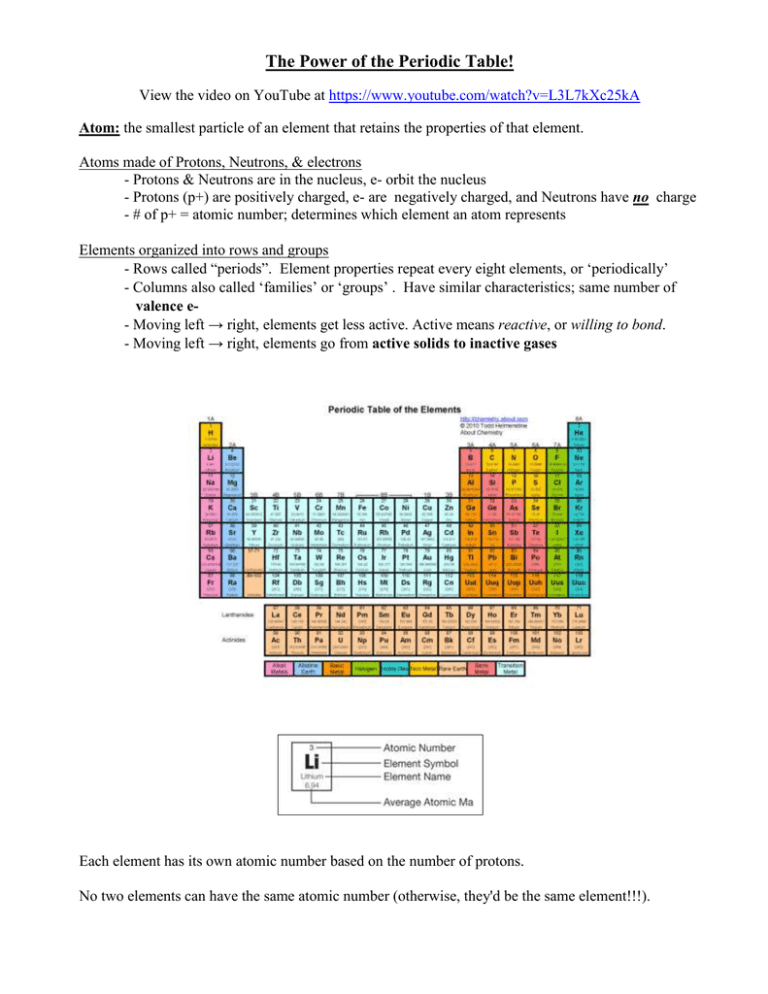
The Power of the Periodic Table! View the video on YouTube at https://www.youtube.com/watch?v=L3L7kXc25kA Atom: the smallest particle of an element that retains the properties of that element. Atoms made of Protons, Neutrons, & electrons - Protons & Neutrons are in the nucleus, e- orbit the nucleus - Protons (p+) are positively charged, e- are negatively charged, and Neutrons have no charge - # of p+ = atomic number; determines which element an atom represents Elements organized into rows and groups - Rows called “periods”. Element properties repeat every eight elements, or ‘periodically’ - Columns also called ‘families’ or ‘groups’ . Have similar characteristics; same number of valence e- Moving left → right, elements get less active. Active means reactive, or willing to bond. - Moving left → right, elements go from active solids to inactive gases Each element has its own atomic number based on the number of protons. No two elements can have the same atomic number (otherwise, they'd be the same element!!!). L to R, top to bottom, atomic # increases by 1 Atomic # = # p+, but also # e- in a neutral atom! Valence e- : e- in the outermost energy level (or shell), furthest from the nucleus Valence e- determine how an atom bonds. * are gained or lost during chemical bonding 1st energy level = 2 e- max. 2nd energy level = 8 e- max. (& all other levels) - Atoms want 8 valence e- Fills outermost energy level - Makes atoms 'happy' Valence e- increase by 1 for families 1, 2, 13, 14, 15, 16, 17, 18 - # of valence e- coincides with Family # Family # 1 2 13 14 15 16 17 18 # of valence electrons 1 2 3 4 5 6 7 8 Family 1: Alkali Metals - The most active metals - 1 valence e- Bond very easily Family 2: Alkaline-Earth Metals - Active metals - Bond easily - 2 valence eTransition Metals - Families 3-12 - Similar properties to each other, but different from other metals - NO valence e- pattern Generally 1 or 2 valence e- Easily give away valence e- -- even other eGeneral Metal Properties - Shiny - Malleable - Ductile - Conduct heat & electricity - Lose e- when bonding # of valence e1 2 3 4 - Have 1 - 4 valence e- # of valence e- lost 1 2 3 4 Nonmetals - Located to the right of the zig-zag line - dull - brittle (unmalleable) - Poor conductors of heat & electricity - Generally have 5 - 8 valence e- GAIN valence e- when bonding # of valence e5 6 7 8 - Gain e- from the metals! - # of valence e- coincides with Family # # of valence e- gained 3 2 1 0 -- Except He!!!! Atomic # 2, so only 2 valence e- Halogens - Family 17 7 valence e- The most active nonmetals ( need only 1 more e- to fill their outermost energy level ) - React very easily with Family 1 (Alkali Metals) Alkali Metals Halogens Lose 1 valence eGain 1 valence eHalogen + any metal = Salt Noble Gases (Also called "Inert Gases") Family 18 -- 8 valence e- (max. amount per level) He = 2 valence e- (2 e- max. in 1st energy level) Noble Gases do not readily bond. (non-reactive) - They do not NEED to gain or lose e- to fill outer energy level - it's already full!!! Metalloids - Combination of metallic & nonmetallic properties - on either side of the zig-zag line Rare - Earth Metals - Located on the bottom just to make the table easier to read! Lanthanoids: - Very soft - High luster (very shiny) - Excellent conductors of heat & electricity - Make alloys & high quality glass Actinoids: Same as Lanthanoids, but RADIOCATIVE Hydrogen! * 1 valence e- ; could lose that e-…like Alkali Metals, but it is a gas (nonmetal) and could gain 1 e* Needs 1 valence e-, like Halogens, but doesn’t already have 7 valence e- ; could lose its e* Very reactive, like Alkali Metals and Halogens * Placed ABOVE Family 1, in upper left - hand corner


